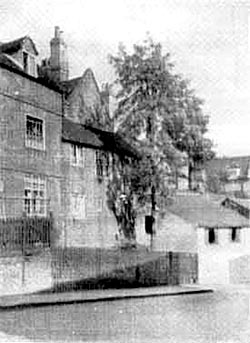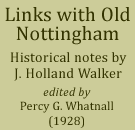< Previous | Contents | Next >
Castle Road
 |
THIS little group of Seventeenth and Eighteenth Century brick buildings that cluster round Walnut Tree-lane, Castle-place, and Castle-road, at the east side of Nottingham Castle, are of great interest, both to the lover of the beautiful and the student of architecture.
Their characteristic painted gables give a delightfully broken sky line, and here and there the iridescence of ancient glass, left forgotten on some old casement or early sash, gives an unexpected touch of colour to the somewhat drab modern surroundings.
Although the user of bricks was well known to the Romans, it fell into disuse in England during the Middle Ages, and was almost an unknown art in these parts until revived under Henry VIII. and Elizabeth.
In those days bricks were very roughly made, and were of whatever size a manufacturer cared to make them. This gave rise to all sorts of difficulties, to correct which Charles I. in 1652 published a proclamation settling the dimensions of bricks as nine inches long, four and three-eighths inches wide, and two and a quarter inches thick. These dimensions have now been altered to nine, by four, by three inches.
In the Sixteenth and Seventeenth Centuries bricks were laid in English bond — one course being all laid as "headers" and the next course as "stretchers." The Flemish bond—each course laid as headers "and" stretchers "alternately—came into use in the Eighteenth Century, and, broadly speaking, has held the field ever since.
